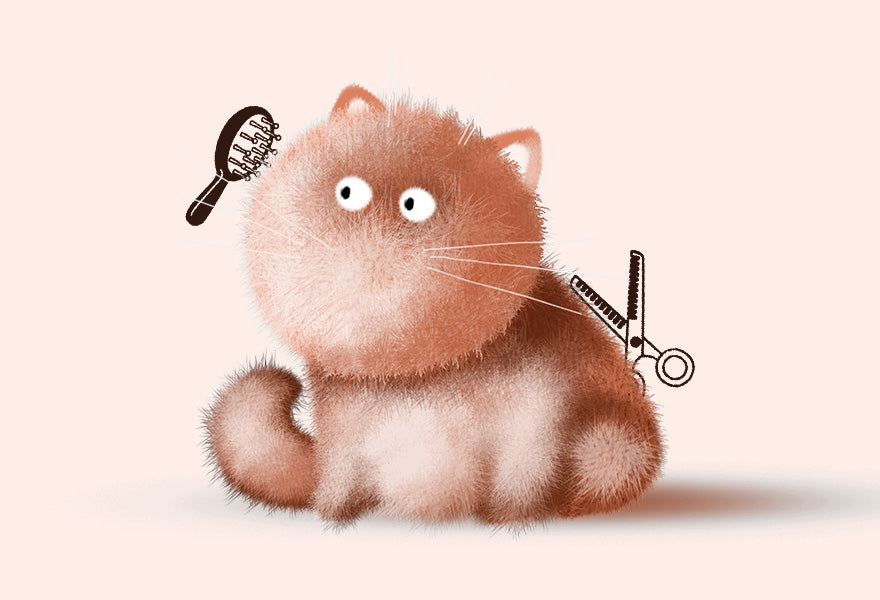
Got Long-Haired Cats? This is How You Can Manage Them
Share
Long-haired cats are gorgeous to look at, and you want to pet them all the time. However, maintaining all that fur can seem daunting if you don't know these few tips and tricks that we are going to tell you in this article.
Be it Persian cats, Rag dolls or Ragamuffins, long-haired cats have beautiful, silky fur, which makes them look like walking, meowing balls of fluff. However, you may be wondering how you would be able to ensure that the fur of your long-haired buddy stays shiny and beautiful always. This article will tell you the most common fur-related problems, and what you can do to prevent them.
The Effect of Changing Seasons
Spring and autumn are when cats tend to shed a lot. As it grows warmer outdoors, they cast off their old winter fur, and replace it with a lighter summer coat. The summer coat protects cats from intense UV radiation and excessive heat. On the other hand, the winter coat, with its thick, insulating layer of hair, protects the cat against the discomfort of cold, wet weather. This is why periodic brushing can help you minimize the impact of seasonal shedding.
Cyclical Shedding
On top of this, the fur on a cat drops off all by itself, based on a cyclical rhythm. This is called the anagenous phase, or a period when new hair roots come into existence naturally.
This is followed by the catagenous phase, a transitional stage. After this, fur stops growing altogether. This is known as the telogenous or rest phase.
At this point, the fur has possibly grown to its full length, but it is still firmly rooted. It starts to fall out in the exogenous phase.
Did you know that in long-haired cats, an incredible 12-24% of the body weight is down to fur?
Cats who live indoors, are particularly prone to moulting. This is because the temperature in the house stays much the same, which means that the cat doesn't have to adjust too much to the heat or the cold.
Things You Can Do to Effectively Deal with Shedding:
Like their short-haired counterparts, long-haired kitties need a high-quality diet, litter boxes to defecate in, and lots of love. Here are a few things you can do, to ensure that their fur stays in the best shape.
1. Brush them daily with a pin brush, to prevent the fur from matting and tangling. Gently brush their body, belly, tail, chin and legs. If you groom them for a little while daily, you won't have to brush them in longer sessions. Some long-haired breeds, such as rag dolls, or Turkish angoras, can go more than a day without brushing, but daily brushing is still best to keep the fur soft, and free of tangles.
2. Use a wide-toothed comb to locate mats in your cat's fur. Sprinkle a little bit of talcum powder over the mat to help loosen the knot. Hold the mat at the base, and gently use the comb to detangle it. Special mat-breaker brushes available in the market, can easily work through the mats. If necessary, cut the mat from the hair with electric clippers.
3. Give your cat a daily dose of hairball-control treats or supplements. Long-haired cats tend to get more hairballs when they ingest their hair while grooming. Hairball-control treats help to lubricate the hair, allowing it to safely pass through your cat's system, instead of winding up on your carpet when your cat vomits.
4. Feed your long-haired kitty a high-fiber diet to help prevent hairballs and the loose stools they sometimes cause. You can also supplement your cat's diet with an occasional teaspoon of canned pumpkin for a fiber boost. Consult your veterinarian about recommendations for hairball-control foods or fiber options.
5. Choose best foods for your cat and kitten that contain omega-3 and omega-6 fatty acids, to keep their fur soft, shiny and healthy. If you feed your cat canned or wet cat food, wipe her mouth and chin daily, using a damp paper towel, to remove any food caught in the long fur of her face.
6. Trim your cat's hindquarters with electric trimmers to prevent fecal matter and litter from sticking to her fur. If you do not want to trim, simply brush her, concentrating on the fur around her hindquarters.
7. Fill your cat's litter box with pelleted, traditional clay, or crystal litter, rather than clumping litter. The fine clumping litter can stick to your cat's long fur. Removing the litter clumps can be difficult and can cause your cat discomfort.